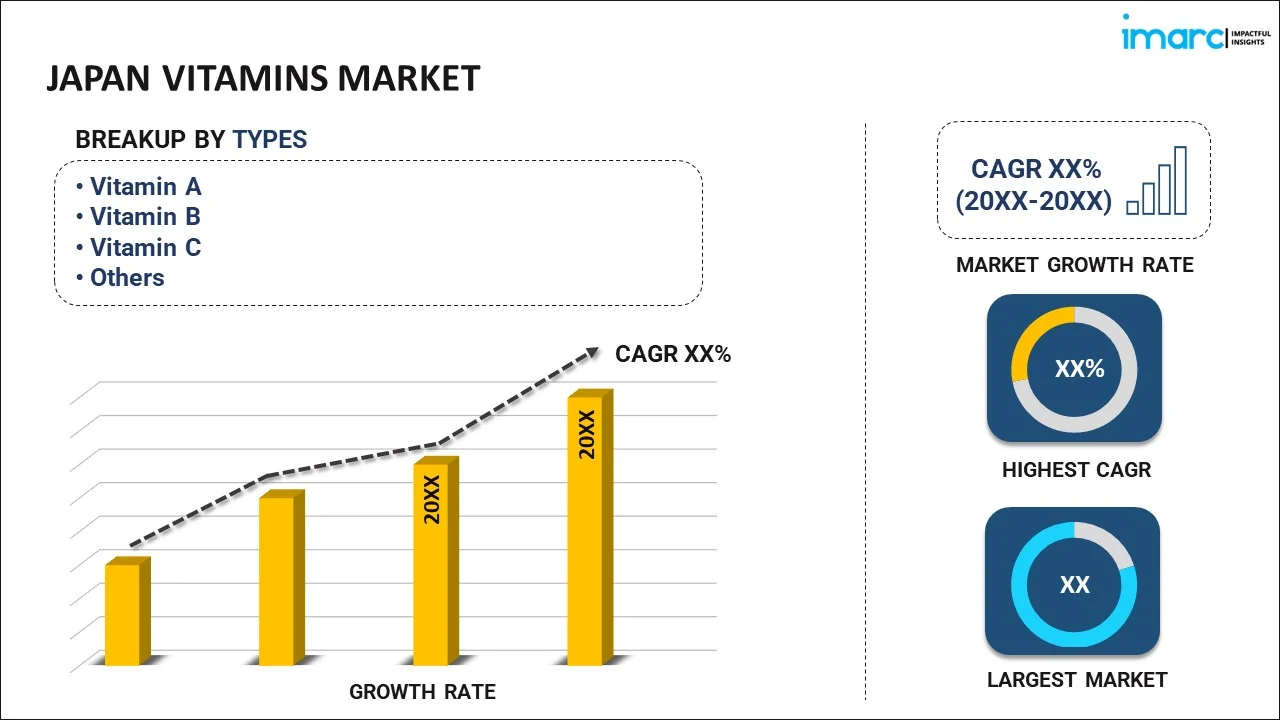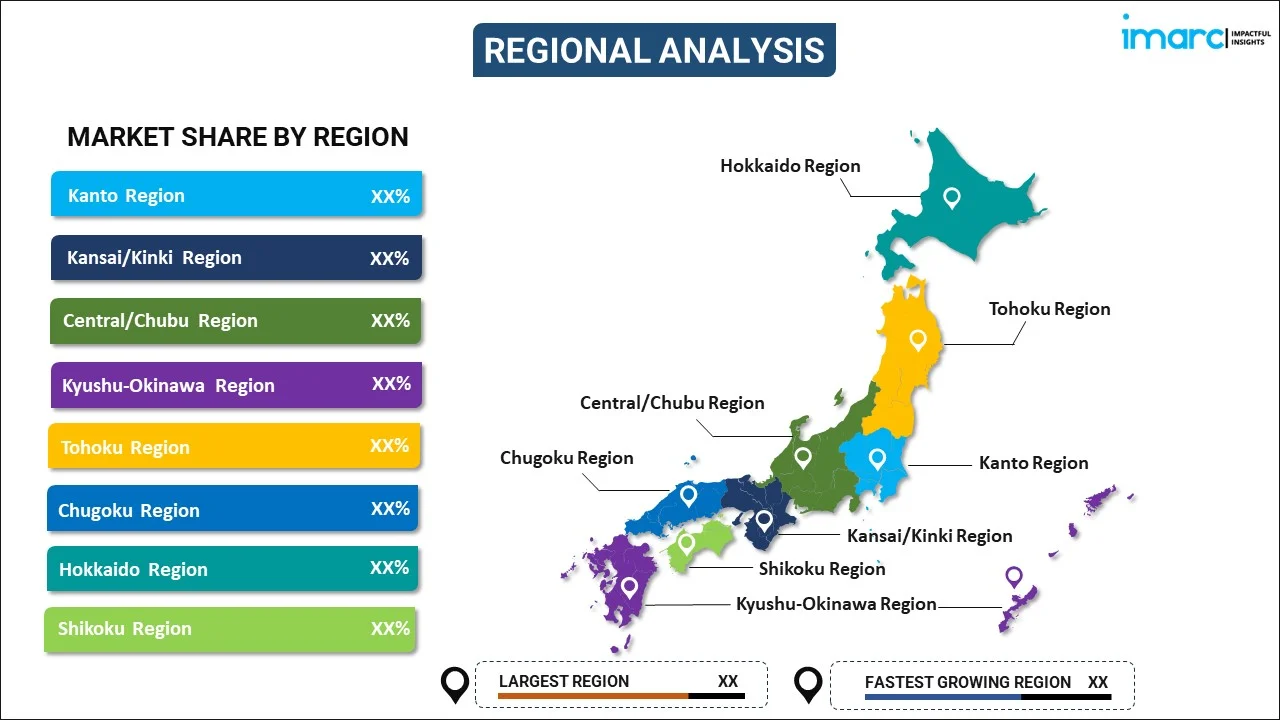
Japan Vitamins Market Report by Type (Vitamin A, Vitamin B, Vitamin C, Vitamin D, Vitamin E, Vitamin K), Source (Natural, Synthetic), Application (Personal Care Products, Food and Beverages, Healthcare Products, and Others), and Region 2026-2034
Market Overview:
Japan vitamins market size reached USD 721.9 Million in 2025. Looking forward, IMARC Group expects the market to reach USD 980.9 Million by 2034, exhibiting a growth rate (CAGR) of 3.47% during 2026-2034. The market is being propelled by several key factors, including the increasing incidence of chronic illnesses, the growing elderly demographic, and the integration of vitamins into functional food and beverage products.
|
Report Attribute
|
Key Statistics
|
|---|---|
|
Base Year
|
2025 |
|
Forecast Years
|
2026-2034
|
|
Historical Years
|
2020-2025
|
| Market Size in 2025 | USD 721.9 Million |
| Market Forecast in 2034 | USD 980.9 Million |
| Market Growth Rate (2026-2034) | 3.47% |
Vitamins are vital organic compounds essential for maintaining optimal health and supporting various bodily functions. These nutrients are primarily obtained through our diet, although some can be synthesized within our bodies. Vitamins are categorized into two main groups: fat-soluble vitamins (A, D, E, and K) and water-soluble vitamins (B-complex vitamins and vitamin C). Fat-soluble vitamins are stored in the body's fatty tissues, whereas water-soluble vitamins must be regularly replenished since they are not stored long-term. These compounds consist of various elements, including carbon, hydrogen, oxygen, and nitrogen, each serving specific functions. Vitamins function as coenzymes or precursors for enzymatic reactions, playing a pivotal role in processes such as energy production, immune system support, cell growth, and tissue repair. They also serve as antioxidants, safeguarding cells from damage caused by harmful free radicals. The advantages of vitamins encompass improved vision, strengthened bone health, enhanced immune system function, increased energy levels, and the promotion of healthier skin.
Japan Vitamins Market Trends:
The Japan vitamins market is primarily fueled by the rising awareness among consumers regarding the benefits of maintaining a healthy lifestyle and preventing nutritional deficiencies. Furthermore, the increasing prevalence of chronic diseases like obesity and cardiovascular ailments has heightened the focus on preventive healthcare, thereby driving the consumption of vitamin supplements. The expanding elderly population, the growth of the nutraceutical industry, and the incorporation of vitamins into functional foods and beverages are also key drivers of market growth. Moreover, rapid technological advancements in product development, including the introduction of innovative delivery formats and nanotechnology, along with the growing influence of social media platforms and celebrity endorsements promoting vitamin benefits, are exerting a positive impact on the market. Additionally, increasing disposable incomes, the rising popularity of vegan and vegetarian diets, and the integration of vitamins into personalized nutrition and wellness programs are further contributing to market growth.
Japan Vitamins Market Segmentation:
IMARC Group provides an analysis of the key trends in each segment of the market, along with forecasts at the country level for 2026-2034. Our report has categorized the market based on type, source, and application.
Type Insights:

- Vitamin A
- Vitamin B
- Vitamin C
- Vitamin D
- Vitamin E
- Vitamin K
The report has provided a detailed breakup and analysis of the market based on the type. This includes vitamin A, vitamin B, vitamin C, vitamin D, vitamin E, and vitamin K.
Source Insights:
- Natural
- Synthetic
A detailed breakup and analysis of the market based on the source have also been provided in the report. This includes natural and synthetic.
Application Insights:
- Personal Care Products
- Food and Beverages
- Healthcare Products
- Others
The report has provided a detailed breakup and analysis of the market based on the application. This includes personal care products, food and beverages, healthcare products, and others.
Regional Insights:

- Kanto Region
- Kansai/Kinki Region
- Central/ Chubu Region
- Kyushu-Okinawa Region
- Tohoku Region
- Chugoku Region
- Hokkaido Region
- Shikoku Region
The report has also provided a comprehensive analysis of all the major regional markets, which include Kanto Region, Kansai/Kinki Region, Central/ Chubu Region, Kyushu-Okinawa Region, Tohoku Region, Chugoku Region, Hokkaido Region, and Shikoku Region.
Competitive Landscape:
The market research report has also provided a comprehensive analysis of the competitive landscape. Competitive analysis such as market structure, key player positioning, top winning strategies, competitive dashboard, and company evaluation quadrant has been covered in the report. Also, detailed profiles of all major companies have been provided.
Japan Vitamins Market Report Coverage:
| Report Features | Details |
|---|---|
| Base Year of the Analysis | 2025 |
| Historical Period | 2020-2025 |
| Forecast Period | 2026-2034 |
| Units | Million USD |
| Scope of the Report | Exploration of Historical Trends and Market Outlook, Industry Catalysts and Challenges, Segment-Wise Historical and Future Market Assessment:
|
| Types Covered | Vitamin A, Vitamin B, Vitamin C, Vitamin D, Vitamin E, Vitamin K |
| Sources Covered | Natural, Synthetic |
| Applications Covered | Personal Care Products, Food and Beverages, Healthcare Products, Others |
| Regions Covered | Kanto Region, Kansai/Kinki Region, Central/ Chubu Region, Kyushu-Okinawa Region, Tohoku Region, Chugoku Region, Hokkaido Region, Shikoku Region |
| Customization Scope | 10% Free Customization |
| Post-Sale Analyst Support | 10-12 Weeks |
| Delivery Format | PDF and Excel through Email (We can also provide the editable version of the report in PPT/Word format on special request) |
Key Questions Answered in This Report:
- How has the Japan vitamins market performed so far and how will it perform in the coming years?
- What has been the impact of COVID-19 on the Japan vitamins market?
- What is the breakup of the Japan vitamins market on the basis of type?
- What is the breakup of the Japan vitamins market on the basis of source?
- What is the breakup of the Japan vitamins market on the basis of application?
- What are the various stages in the value chain of the Japan vitamins market?
- What are the key driving factors and challenges in the Japan vitamins?
- What is the structure of the Japan vitamins market and who are the key players?
- What is the degree of competition in the Japan vitamins market?
Key Benefits for Stakeholders:
- IMARC’s industry report offers a comprehensive quantitative analysis of various market segments, historical and current market trends, market forecasts, and dynamics of the Japan vitamins market from 2020-2034.
- The research report provides the latest information on the market drivers, challenges, and opportunities in the Japan vitamins market.
- Porter's five forces analysis assist stakeholders in assessing the impact of new entrants, competitive rivalry, supplier power, buyer power, and the threat of substitution. It helps stakeholders to analyze the level of competition within the Japan vitamins industry and its attractiveness.
- Competitive landscape allows stakeholders to understand their competitive environment and provides an insight into the current positions of key players in the market.
Need more help?
- Speak to our experienced analysts for insights on the current market scenarios.
- Include additional segments and countries to customize the report as per your requirement.
- Gain an unparalleled competitive advantage in your domain by understanding how to utilize the report and positively impacting your operations and revenue.
- For further assistance, please connect with our analysts.
 Request Customization
Request Customization
 Speak to an Analyst
Speak to an Analyst
 Request Brochure
Request Brochure
 Inquire Before Buying
Inquire Before Buying




.webp)




.webp)












